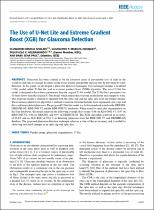JavaScript is disabled for your browser. Some features of this site may not work without it.
- ResearchSpace
- →
- Research Publications/Outputs
- →
- Journal Articles
- →
- View Item
| dc.contributor.author |
Afolabi, OJ

|
|
| dc.contributor.author |
Mabuza-Hocquet, Gugulethu P

|
|
| dc.contributor.author |
Nelwamondo, Fulufhelo V

|
|
| dc.contributor.author |
Paul, BS

|
|
| dc.date.accessioned | 2021-07-13T17:11:57Z | |
| dc.date.available | 2021-07-13T17:11:57Z | |
| dc.date.issued | 2021-03 | |
| dc.identifier.citation | Afolabi, O., Mabuza-Hocquet, G.P., Nelwamondo, F.V. & Paul, B. 2021. The use of U-Net lite and Extreme Gradient Boost (XGB) for glaucoma detection. <i>IEEE Access, 9.</i> http://hdl.handle.net/10204/12048 | en_ZA |
| dc.identifier.issn | 2169-3536 | |
| dc.identifier.uri | DOI: 10.1109/ACCESS.2021.3068204 | |
| dc.identifier.uri | http://hdl.handle.net/10204/12048 | |
| dc.description.abstract | Glaucoma has been credited to be the foremost cause of preventable loss of sight in the world second only to cataract. Its effect on the eye is usually irreversible and can only be prevented by early detection. In this paper, we developed a glaucoma detection technique. This technique includes a modified U-Net model called ‘U-Net lite’ and an extreme gradient boost (XGB) algorithm. The novel U-Net lite model is designed to have fewer parameters than the original U-Net model. The U-Net lite’s parameters are 40 times fewer than the original U-Net model which makes the proposed model faster and cheaper to train. The proposed model is utilized to segment both the optic cup and the optic disc from the fundus images. The extreme gradient boost algorithm is utilized to analyze extracted features from segmented optic cups and discs and hence detect glaucoma. The proposed U-Net lite model was both trained and tested on the DRIONS, DRISHTI-GS, RIM-ONE V2 and the RIM-ONE V3 databases. When tested for optic disc segmentation on the four databases, the model achieved the following average dice-scores: 0.96 on RIM-ONE V3, 0.97 on RIM-ONE V2, 0.96 on DRIONS, and 0.97 on DRISHTI-GS. The XGB algorithm achieved an accuracy of 88.6% and an AUC-ROC of 93.6 % in detecting glaucoma from the RIM-ONE V3 and DRISHTI-GS database. The proposed glaucoma detection technique achieves a state-of-the-art accuracy and is useful for observing structural changes in an optic cup and optic disc. | en_US |
| dc.format | Fulltext | en_US |
| dc.language.iso | en | en_US |
| dc.relation.uri | https://ieeexplore.ieee.org/document/9383215 | en_US |
| dc.source | IEEE Access, 9 | en_US |
| dc.subject | Fundus image | en_US |
| dc.subject | Glaucoma | en_US |
| dc.subject | Segmentation | en_US |
| dc.subject | U-Net | en_US |
| dc.subject | Extreme Gradient Boost | en_US |
| dc.subject | XGB | en_US |
| dc.title | The use of U-Net lite and Extreme Gradient Boost (XGB) for glaucoma detection | en_US |
| dc.type | Article | en_US |
| dc.description.pages | 47411-47424 | en_US |
| dc.description.note | This work is licensed under a Creative Commons Attribution 4.0 License | en_US |
| dc.description.cluster | Defence and Security | en_US |
| dc.description.cluster | Next Generation Enterprises & Institutions | |
| dc.description.impactarea | Optronic Sensor Systems | en_US |
| dc.description.impactarea | Directorate | |
| dc.identifier.apacitation | Afolabi, O., Mabuza-Hocquet, G. P., Nelwamondo, F. V., & Paul, B. (2021). The use of U-Net lite and Extreme Gradient Boost (XGB) for glaucoma detection. <i>IEEE Access, 9</i>, http://hdl.handle.net/10204/12048 | en_ZA |
| dc.identifier.chicagocitation | Afolabi, OJ, Gugulethu P Mabuza-Hocquet, Fulufhelo V Nelwamondo, and BS Paul "The use of U-Net lite and Extreme Gradient Boost (XGB) for glaucoma detection." <i>IEEE Access, 9</i> (2021) http://hdl.handle.net/10204/12048 | en_ZA |
| dc.identifier.vancouvercitation | Afolabi O, Mabuza-Hocquet GP, Nelwamondo FV, Paul B. The use of U-Net lite and Extreme Gradient Boost (XGB) for glaucoma detection. IEEE Access, 9. 2021; http://hdl.handle.net/10204/12048. | en_ZA |
| dc.identifier.ris | TY - Article AU - Afolabi, OJ AU - Mabuza-Hocquet, Gugulethu P AU - Nelwamondo, Fulufhelo V AU - Paul, BS AB - Glaucoma has been credited to be the foremost cause of preventable loss of sight in the world second only to cataract. Its effect on the eye is usually irreversible and can only be prevented by early detection. In this paper, we developed a glaucoma detection technique. This technique includes a modified U-Net model called ‘U-Net lite’ and an extreme gradient boost (XGB) algorithm. The novel U-Net lite model is designed to have fewer parameters than the original U-Net model. The U-Net lite’s parameters are 40 times fewer than the original U-Net model which makes the proposed model faster and cheaper to train. The proposed model is utilized to segment both the optic cup and the optic disc from the fundus images. The extreme gradient boost algorithm is utilized to analyze extracted features from segmented optic cups and discs and hence detect glaucoma. The proposed U-Net lite model was both trained and tested on the DRIONS, DRISHTI-GS, RIM-ONE V2 and the RIM-ONE V3 databases. When tested for optic disc segmentation on the four databases, the model achieved the following average dice-scores: 0.96 on RIM-ONE V3, 0.97 on RIM-ONE V2, 0.96 on DRIONS, and 0.97 on DRISHTI-GS. The XGB algorithm achieved an accuracy of 88.6% and an AUC-ROC of 93.6 % in detecting glaucoma from the RIM-ONE V3 and DRISHTI-GS database. The proposed glaucoma detection technique achieves a state-of-the-art accuracy and is useful for observing structural changes in an optic cup and optic disc. DA - 2021-03 DB - ResearchSpace DP - CSIR J1 - IEEE Access, 9 KW - Fundus image KW - Glaucoma KW - Segmentation KW - U-Net KW - Extreme Gradient Boost KW - XGB LK - https://researchspace.csir.co.za PY - 2021 SM - 2169-3536 T1 - The use of U-Net lite and Extreme Gradient Boost (XGB) for glaucoma detection TI - The use of U-Net lite and Extreme Gradient Boost (XGB) for glaucoma detection UR - http://hdl.handle.net/10204/12048 ER - | en_ZA |
| dc.identifier.worklist | 24664 | en_US |






